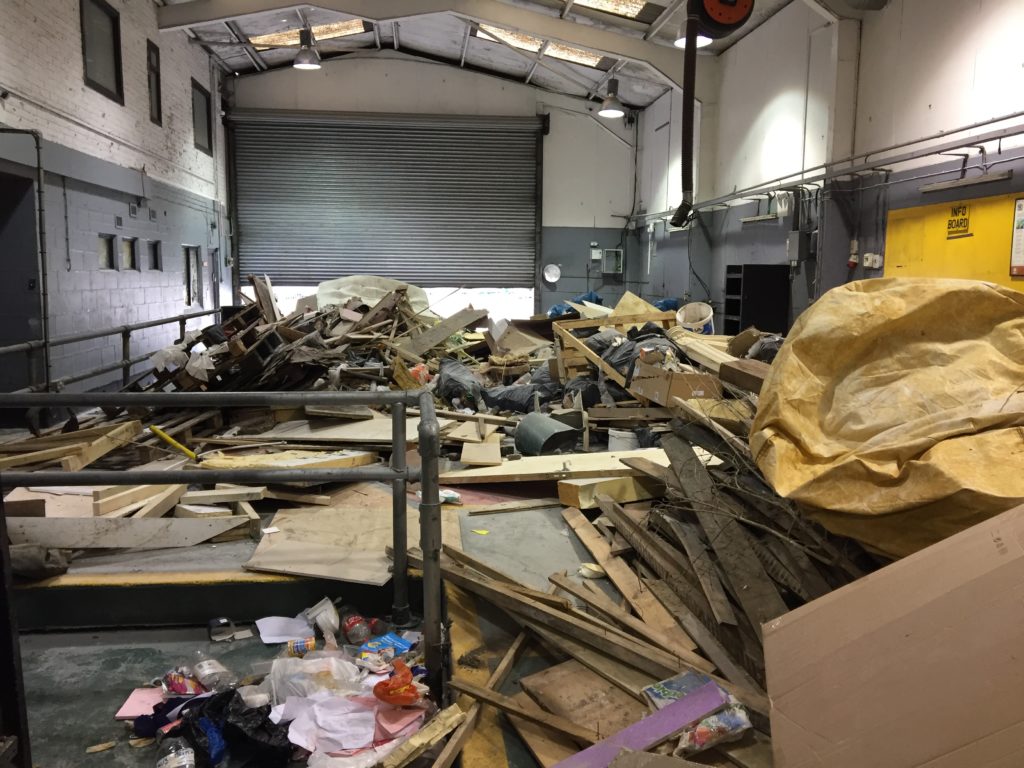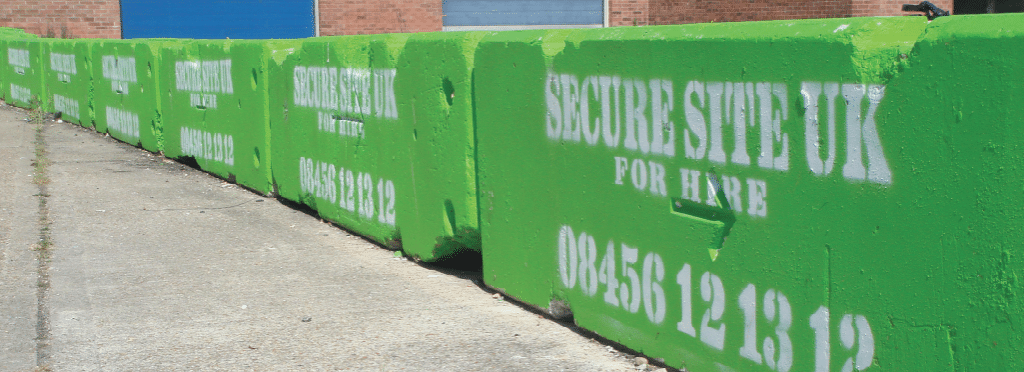Concrete barriers and blocks are a simple and effective way to secure your premises against unauthorised access from trespassers. They are also suitable for controlling traffic flows, securing building sites and shielding roadworks, protecting both the passing public and workforce within.
Concrete was the material of choice for construction barriers for a long time. And they are still utilised as medians along some roadsides by construction companies today.
Plastic barricades were developed as alternatives to concrete barriers as the barricade industry progressed, however, they are not as effective as concrete.
If you want to learn about concrete barriers, sometimes known as Jersey Barriers, continue reading…
How Do Concrete Barriers Provide Protection?
Trespassing is not a criminal offence in itself, but when space is used to import waste is when it becomes a problem. Sometimes this rubbish includes hazardous waste such as asbestos, with clear ups often running into tens of thousands of pounds.
Due to trespassing not being a criminal offence, trying to get the police involved is often difficult because as it’s a civil matter and there will be little they can do.
Concrete road barriers provide protection by preventing access of trespassers to a vacant property and providing physical defences by blocking vehicles.
Before we get into the advantages of concrete barriers for the security of your vacant property, it’s important to understand the many types of barriers that are available.
Certain barriers, usually concrete or plastic, will be better suited to specific purposes.
Different Types of Concrete Barriers
TVCBs (Temporary Vertical Concrete Barriers), Lego Blocks, Jersey barriers, and other customised precast concrete barriers are examples of concrete barriers. These barriers are better suited to construction sites, residential areas, and commercial locations due to their strength and longevity.
Temporary Vertical Concrete Barriers (TVCBs)
TVCBs are designed for motorway/carriageway protection, and when they’re bolted together, they create a barrier that will offer protection against vehicles travelling at 70MPH because they weigh 2 and a half tonnes. They are National Highways EN 1317-2 Compliant and approved, which means they’re put through vigorous tested and are fit to protect different sites.
When it comes to placement, a forklift or a crane is what’s used to ensure they can be put into correct positions. They’re transported in lorries and you can have either 6 or 10 barriers on one lorry.
Plastic Barriers
Plastic barriers, on the other hand, are better suited to light-duty use and will, be employed as an effective approach during a roadside repair, for example. Water-filled or sand-filled plastic barriers are the most common types.
However, concrete barriers are, without a doubt, the best solution to prevent access and provide physical defence because there are quite a few drawbacks to plastic.
Plastic can be flimsy and, subsequently, will not offer you a strong solution that concrete barriers can – defeating the purpose of strength and protection.
When these plastic barriers are water-filled, they become quite expensive because they can take 2000 litres to fill.
Trespassers can easily damage plastic barriers, draining the water to effortlessly move them out of the way, giving them easy access to car parks, entryways and other unauthorised premises.
The Advantages Of Concrete Barrier Blocks
While some barriers can be used temporarily, others prove to be useful in the long term. Here are the benefits of concrete barriers for your unique sites…
Concrete Barriers Are Strong And Can’t Be Knocked Over Easily
The concrete barriers are 3000Lx800hx450w, weighing 2.5 tonnes and are joined together through M25 threaded bolts.
Whether they’re used for properties, commercial premises or plots of land, the weight of a concrete barrier makes it almost impossible to breach.
There are options to bolt our large TVCB together, creating a stronger and more robust security solution.
This is done by bolting blocks that join together. ‘Single 3-metre wide barriers thwart unauthorised vehicle access to driveways, whilst entire perimeters or particularly risky sites can be secured with barriers bolted together to provide additional protection. Bolting together is just £50 per pair and instantly increases the mass would-be trespassers need to 5, 7.5 or 10 tonnes and beyond their vehicles’ capacity to move!’
Concrete Barriers Are Durable
The strength of the barriers means that the systems offer an optimum, durable solution that’s suitable for long-term projects.
A specialist swing gate that is counterweighted by the barriers can be used for long-term projects because you can gain access to your sites without having to forklift the barriers each time you want to access them.
These swing gates are secured by the weight of the concrete barrier and can be protected by padlocks to ensure maximum security.
Optimising Safety
Concrete barriers can guarantee safety from additional hazards due to their strength and durability.
For example, by keeping public and vehicles at a safe distance from debris or specific hazards, such as dangerous structures, landslides or deep water.
Concrete Barriers: Creating Ballasts
Concrete barriers can also be used as counterweights to secure temporary structures such as marquees, scaffolding and hoardings, to name a few.
Sandbags can also be propped against concrete barriers, to create a solid solution to prevent flooding damage for example.
And for added protection, fencing or hoarding can be added to increase the height of your security solution to approximately 2.5 metres.

What Else Can Concrete Road Barriers Be Used For?
There are virtually limitless possibilities for use and deployment across a variety of residential, commercial and industrial purposes. Such use of concrete barriers generally includes, but isn’t limited to:
1. Providing Protection Against Unauthorised Access
While using steel screens to ‘board up’ your windows and doors is one of the most efficient ways to limit access to your property, it won’t do anything to safeguard the area around it.
Those intending to park their vehicles or make use of your land may find parking places and garden areas appealing.
Installing 3 metres wide, 2.5-tonne concrete blocks across all entrance points to your property will essentially shut off this behaviour at the source, preventing you, the property owner, from having to pay for costly rubbish removal services.
2. Preventing Fly-Tipping
According to the government, local authorities in England dealt with little under one million (976,000) fly-tipping cases in 2019/2020, up 2% from the 957,000 reported in 2018/19.
While these figures don’t solely reflect what happens in unoccupied buildings, they do serve as a sharp reminder that fly-tipping is still a problem in England.
If you don’t want to return to a property that has been turned into a dumping ground, it’s highly recommended that you prevent fly-tipping by installing concrete barriers at all of your property’s entrances.
3. Preventing Illegal Trespassing
If you own a portfolio of buildings or property that has been unoccupied, unauthorised trespasser encampments can become a serious problem.
When an ‘open’ site is discovered, word spreads rapidly, and caravans emerge before you know it.
However, a few strategically placed concrete blocks will halt this illegal activity, sparing you the trouble.
While adopting a nomadic lifestyle is not unlawful in and of itself, it can become troublesome it entails trespassing on someone’s property.
4. Can Be Used For Vehicle Security
Having concrete vehicle barriers in place can be used to dedicate parking spaces in carparks at events, industrial estates or offices.
They can also be used to guide traffic to ensure that it is controlled and vehicles are heading in the right places. This might be necessary at large events or where there might be road work in place. This will provide a steady flow of traffic and help ensure that drivers feel in the know about where they’re heading.
It can also be used to block vehicles from getting into sites or secure premises such as airports for example.
Concrete barriers can also be used as pedestrian walkways, ensuring that pedestrians have paths they can walk freely down without getting in the way of vehicles.
5. Motorway/Carriageway Protection
As mentioned earlier, TVBC’s are designed to deflect vehicles away from local hazards that are within or close proximity to motorways or carriageways.
Motorways and carriageways have the potential to cause danger to the occupants of an errant vehicle, the workforce, or others – having a TVBC in place will greatly reduce these risks.
6. Prevents Flood Damage
Concrete barriers can be used to prevent flood damage. A 900mm barrier in conjunction with sandbags can provide a secure solution to avoid destruction.
Sandbags alone are not effective against flood damage because they can get easily knocked down. However, when sandbags are used propped against concrete barriers, they create a solid solution to protect against damage from water.
The barriers are able to withstand extreme flooding, without the risk of floating away and becoming another potential hazard to already destroyed areas.
Not only are they easy to install, but they can often be placed within 24 hours. Where traditional flood barriers and in-situ walls require significant building work, concrete barriers can be placed at short notice; and time is of the essence, especially when dealing with a flash flooding situation.
Customisable Concrete Barriers
You take pride in maintaining your property to a high standard as a landlord or property manager. That’s why it’s crucial to remember that concrete barriers can be customised to blend in with their surroundings, regardless of where they’re needed. Concrete barriers can be painted any colour to complement their surroundings or even show a logo and corporate name.
Concrete barriers will do the job and safeguard what’s worth protecting, whether you want them to fit in or stick out.
Concrete blocks may not be the first thing you think of, but they are more than effective against flooding, fly-tipping, trespassing, hazards created by vehicles, as well as a vacant property security solution.
Speed Of Concrete Barrier Hire To Your Site
With Secure Site, you’ll get an immediate solution with your concrete barriers because they are placed within the next day or even on the same day.
Once a plan is signed off with what you want and where you want it placed, we can deliver and position the barriers without the need to have someone on-site – freeing up your time.
Conclusion
In much the same way you’d select a guarding service or CCTV, the number of barriers will be dependent on your unique requirements. The best way to understand this would be via a site assessment, which will confirm the best security solutions to meet your needs.
Do you have a site or premises that would benefit from the use of concrete barriers? Don’t hesitate to speak to an expert today.










